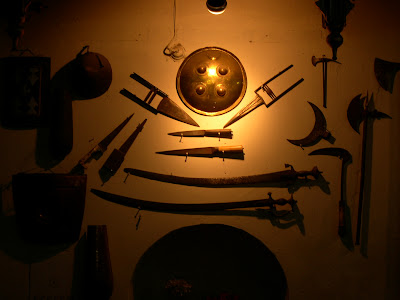The lavish abodes of royalty, Fakir Khana Museum offers a glimpse into the regal lifestyles where tourists are treated as guests of the Fakir family. The ambience, in keeping with their history, architecture and traditions add old world charm. Fakir Khana Museum's heritage is an insight in the varied facets of the country's history, religious and cultural contrasts, and its indigenous lifestyles still untouched by the trappings of modernity. Enjoy the Fakir Khana Collection experience by following the following links:
Museum Hours :
During the working days opening & closing times are as follows:
Winter:
October 1st to April 15th
9:00 am to 4:00 pm
Summer:
April 16th to September 30th
9:00 am to 5:00 pm
Holidays: (museum will be closed on)
Fakir khana museum is open to public on all days except Saturdays and days corresponding to Juma tul wida (last Friday of Ramadan) Eid ul Fitr, Eid ul Zoha, Miladun Nabi, 9th and 10th of the Holy month of Muharram, 1st may (May day), 11ty September (Quaids anniversary) & first Wednesday of each month for general cleanliness
Admission: There are no charges for admission into the museum however prior appointment is required to your visit through telephone, fax or email. In the event any visits are arranged to the museum without appointment, rights of admission to the Fakir Khana Museum are reserved by the Fakir Khana Trust and the Museum staff.
Photography: Still photography is permitted for private, noncommercial use only in the Museum's Halls. Photographs cannot be published, sold, reproduced, transferred, distributed, or otherwise commercially exploited in any manner whatsoever. Photography is not permitted in special exhibitions or areas designated as "No Photography"; The use of a flash is prohibited. Movie and video cameras are prohibited. Tripods are allowed, and only with a permit of the Curator. The Museum reserves the right, at its sole discretion, to withhold and/or withdraw permission to photograph on its premises or to reproduce photographs of objects in its collection.
Location The museum is located (near kucha Pehalwanan) in Bazar Hakiman, off Bhatti gate, one of the 13 gates which once pierced the 30 feet high fortification wall surrounding the old city. Visitors can easily reach Bazar hakiman either through the western gate of Hazoori Bagh (after the visit of Badshai mosque and Lahore fort) or through Rang Mahal Chowk. Visitors using a taxi/private vehicle are advised to enter Bazar Hakiman either from the north (Taxali Gate or Masti Gate) or from south "Bhatti gate"; Visitors using urban transport or Omnibus service should get down to Bhatti gate or Taxali gate.
Other Facilities: There is no restaurant or canteen in the museum. However cool drinks as well as traditional scented sharbat, fruit juices, local edibles of good quality are available in shops close by. Milk & lassi (a drink made of yogurt) is available just at the main gate of the museum. For lunchtime a very delicious traditional food is available near the museum which include: nihari, phajja paye, Haleem, Murgh Chanay, Dal tikki, Keema walay nan, and a lot more.
Children: Children below the age of 12 are not allowed in the Museum Collection display area
Guide Facility: No regular guide service is available. However, for any additional information contact the Coordinator or the General Secretary Fakir Khana Museum.
Students or groups visiting Fakir khana are advised to take appointment first so that special arrangements can be made to facilitate them


